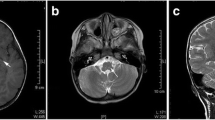Abstract
POEMS syndrome is a potentially fatal disease, and prediction of prognostic factors for POEMS syndrome is important for clinicians. Papilloedema is an early sign of the syndrome. The present study was carried out to evaluate whether papilloedema is a prognostic factor for POEMS syndrome. Between January 2003 and December 2012, 94 patients with POEMS syndrome were enrolled in this study. The patients were divided into groups with and without papilloedema. Logistic regression was performed to identify risk factors related to papilloedema. Prognostic factors were analysed with Cox proportional hazard regressions for POEMS syndrome-related prognoses, and survival curves were plotted using the Kaplan–Meier method and compared by the log-rank test. Papilloedema was found in 52.1 % of the patients with POEMS syndrome. Raised intracranial pressure [hazard ratio (HR) 3.06, 95 % confidence interval (CI) 1.24–7.41; P = 0.011] and elevated cerebrospinal fluid protein levels (HR 2.03, 95 % CI 1.07–4.51; P = 0.043) were independently associated with papilloedema. Papilloedema, decreased diffusing capacity of the lung for carbon monoxide (DLCO) and treatment with corticosteroids alone were related to poor prognosis in POEMS syndrome. In multivariate analysis, papilloedema (HR 1.58, 95 % CI 1.05–2.46; p = 0.027) and decreased DLCO (HR 2.17, 95 % CI 1.12–3.39; p = 0.023) were independent factors for POEMS syndrome-related death. Papilloedema and decreased DLCO are important prognostic factors for patients with POEMS syndrome, which can help clinicians predict the risk of mortality and provide better medical care for these patients.

Similar content being viewed by others
References
Nakanishi T, Sobue I, Toyokura Y et al (1984) The Crow-Fukase syndrome: a study of 102 cases in Japan. Neurology 34:712–720
Cui RT, Huang XS, Shi Q et al (2011) POEMS (polyneuropathy, organomegaly, endocrinopathy, M-protein and skin changes) syndrome in China. Intern Med J 41:481–485
Cui RT, Huang XS, Liu JX et al (2012) Electrophysiological characteristics of polyneuropathy in POEMS syndrome: comparison with CIDP. J Clin Neurophysiol 29:345–348
Dispenzieri A, Kyle RA, Lacy MQ et al (2003) POEMS syndrome: definitions and long-term outcome. Blood 101:2496–2506
Dispenzieri A (2012) POEMS syndrome: update on diagnosis, risk-stratification, and management. Am J Hematol 87:805–814
Kaushik M, Pulido JS, Abreu R et al (2011) Ocular findings in patients with polyneuropathy, organomegaly, endocrinopathy, monoclonal gammopathy, and skin changes syndrome. Ophthalmology 118:778–782
Chong DY, Comer GM, Trobe JD (2007) Optic disc edema, cystoid macular edema, and elevated vascular endothelial growth factor in a patient with POEMS syndrome. J Neuroophthalmol 27:180–183
Bourdette DN, Rosenberg NL (1984) Infiltrative orbitopathy, optic disk edema, and POEMS. Neurology 34:532–533
Dispenzieri A (2007) POEMS syndrome. Blood Rev 21:285–299
Carta A, Favilla S, Prato M et al (2012) Accuracy of funduscopy to identify true edema versus pseudoedema of the optic disc. Invest Ophthalmol Vis Sci 53:1–6
Agarwal AK, Yadav P, Sharma RK et al (2000) Papilloedema (choked disc). J Indian Acad Ckin Med 1:271–277
Soubrier MJ, Dubost JJ, Sauvezie JM et al (1994) POEMS syndrome: a study of 25 cases and a review of the literature; French study group on POEMS syndrome. Am J Med 97:543–553
Wong VA, Wade NK (1998) POEMS syndrome: an unusual cause of bilateral optic disk swelling. Am J Ophthalmol 126:452–454
Bolling JP, Brazis PW (1990) Optic disk swelling with peripheral neuropathy, organomegaly, endocrinopathy, monoclonal gammopathy, and skin changes (POEMS syndrome). Am J Ophthalmol 109:503–510
Briani C, Fabrizi GM, Ruggero S et al (2011) Vascular endothelial growth factor helps differentiate neuropathies in rare plasma cell dyscrasias. Muscle Nerve 43:164–167
D’Souza A, Hayman SR, Buadi F et al (2011) The utility of plasma vascular endothelial growth factor levels in the diagnosis and follow-up of patients with POEMS syndrome. Blood 118:4663–4665
Shiraki T, Satoh S, Sugiyama H et al (2005) Highly concentrated vascular endothelial growth factor in Crow-Fukase syndrome with high output heart failure: a case report. J Cardiol 45:75–80
Scarlato M, Previtali SC, Carpo M et al (2005) Polyneuropathy in POEMS syndrome: role of angiogenic factors in the pathogenesis. Brain 128:1911–1920
Yamada Y, Sawai S, Misawa S et al (2013) Multiple angiogenetic factors are upregulated in POEMS syndrome. Ann Hematol 92:245–248
Thoennissen GB, Thoennissen NH, Fritz F et al (2012) POEMS syndrome treated with melphalan high-dose therapy and autologous blood stem cell transplantation: a single-institution experience. Ann Hematol 91:1419–1425
Wong VA, Wade NK (1998) POEMS syndrome: an unusual cause of bilateral optic disk swelling. Am J Ophthalmol 126:452–454
Bolling JP, Brazis PW (1990) Optic disk swelling with peripheral neuropathy, organomegaly, endocrinopathy, monoclonal gammopathy, and skin changes (POEMS syndrome). Am J Ophthalmol 109:503–510
Wiaux C, Landau K, Borruat FX (2007) Unusual cause of bilateral optic disc swelling: POEMS syndrome. Klin Monbl Augenheilkd 224:334–336
Niimi H, Arimura K, Jonosono M et al (2000) VEGF is causative for pulmonary hypertension in a patient with Crow-Fukase (POEMS) syndrome. Intern Med 39:1101–1104
Allam JS, Kennedy CC, Aksamit TR et al (2008) Pulmonary manifestations in patients with POEMS syndrome: a retrospective review of 137 patients. Chest 133:969–974
Szollosi I, Thompson BR, Krum H et al (2008) Impaired pulmonary diffusing capacity and hypoxia in heart failure correlates with central sleep apnea severity. Chest 134:67–72
Peter L, Jacob M, Krolak-Salmon P et al (2007) Prevalence of papilloedema in patients with sleep apnoea syndrome: a prospective study. J Sleep Res 16:313–318
Conflict of interest
On behalf of all authors, the corresponding author states that there is no conflict of interest.
Author information
Authors and Affiliations
Corresponding author
Rights and permissions
About this article
Cite this article
Cui, R., Yu, S., Huang, X. et al. Papilloedema is an independent prognostic factor for POEMS syndrome. J Neurol 261, 60–65 (2014). https://doi.org/10.1007/s00415-013-7143-4
Received:
Revised:
Accepted:
Published:
Issue Date:
DOI: https://doi.org/10.1007/s00415-013-7143-4




